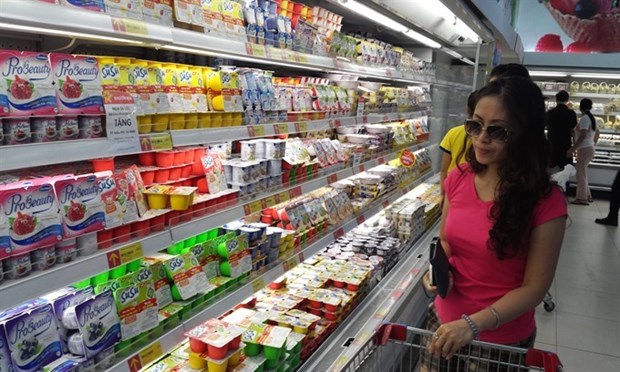Inflation predicted to stay below 4 percent in 2018: Ministry
The Ministry of Finance (MoF) has outlined three scenarios for inflation in 2018, with the consumer price index (CPI) in all circumstances staying below 4 percent, the target set by the National Assembly.
 Illustrative image (Source: VNA)
Illustrative image (Source: VNA)Hanoi (VNA) - The Ministry of Finance (MoF) has outlined three scenarios for inflation in 2018, with the consumer price index (CPI) in all circumstances staying below 4 percent, the target set by the National Assembly.
In the first scenario, food prices are expected to remain relatively stable and only rise slightly during the holidays.
Hikes in health care costs in the first quarter are projected to increase the CPI by 0.17 percent, while wage increases and higher power costs will drive up the CPI by 0.14 percent and 0.1 percent respectively.
A 5 percent increase each in petrol and gas prices will lift the CPI by 0.28 percent and 0.06 percent respectively.
After factoring in these price rises, the average CPI in 2018 is expected to rise by 3 percent.
In the second scenario, which is largely the same as the first one, with the exception that pork prices rise by 7 percent at the end of the year and petrol and gas prices increase by 10 percent, the average CPI in 2018 will rise by 3.4 percent.
Meanwhile the average CPI will increase by 3.9 percent in the third scenario, assuming a 15 percent rise in pork prices and 15 percent hikes in petrol and gas prices with other price increases the same as in the first scenario.
According to the General Statistics Office (GSO), Vietnam’s average inflation in 2017 fell from 5.22 percent in January to 3.61 percent in November.
The year 2017 is considered a successful year in inflation control, as the average CPI increased 3.53 percent over 2016 and 2.6 per cent compared to December 2016, fulfilling the target of keeping the rate under 4 percent for the whole year, GSO Nguyen Bich Lam said during a meeting last week.
Lam pointed out major reasons behind the CPI rise, including hikes in the prices of health care and education services, as well as an increase in regional minimum wage.
At the same time, domestic fuel prices in 2017 rose 15.49 percent compared to 2016, contributing 0.64 percent in CPI increase for the whole year.
The price of construction materials was up 5.23 percent due to increases in the prices of sand and steel. Rising prices of essential goods in the global market also pushed the import price index up by 2.57 percent and export price index up by 2.93 percent; the Producer Price Index (PPI) expanded by 2.82 percent.
Lam underscored that a record number of 16 storms were seen in 2017, which pushed up the prices of food and foodstuff in affected localities, especially central provinces.
Meanwhile, there were a number of factors helping rein in inflation, including a downturn of 2.6 percent in food prices in 2017, helping reduce the overall CPI by about 0.53 percent.
GSO Director Nguyen Bich Lam attributed the success in meeting the inflation target for the year to efforts of ministries in encouraging businesses’ involvement in stocking goods and stabilising the market.
The Ministry of Finance had kept a close watch on market developments, while coordinating with the Ministry of Industry and Trade to manage fuel prices, he said.-VNA













